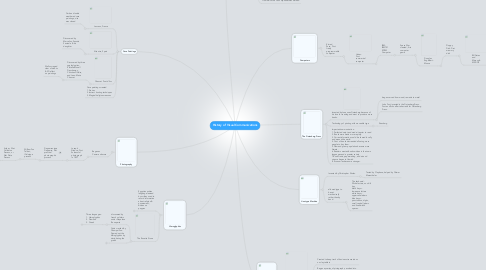
1. Cave Paintings
1.1. Lascaux, France
1.1.1. Carbon dioxide weathered cave paintings; site was closed
1.2. Altamira, Spain
1.2.1. Discovered by Marcelino Sanz de Sautoula & his daughter
1.3. Chauvet Pont d'Arc
1.3.1. Discovered by three speleologists: Elittelle Brunell Deschamps, Christian Hillaire, and Jean-Marie Chauvet
1.3.1.1. Walls scraped clear of debris & 3D effect on paintings
1.4. Cave paintings created 1. Stories 2. Instruct hunting techniques 3. Magical/religious reasons
2. Hieroglyphics
2.1. Egyptian written language learned by scribes used to record information about religion & government; written on papyrus
2.1.1. New node
2.2. The Rosetta Stone
2.2.1. discovered by french soldiers under Napoleon Bonaparte
2.2.1.1. Three languages: 1. Hieroglyphics 2. Demonic 3. Greek
2.2.1.1.1. New node
2.2.2. Code cracked by Champoillon: Figured out the hieroglyphics by deciphering the greek
2.2.2.1. New node
3. The Phonetic Alphabet
3.1. Origins unknown/believed origins: 1. Began in 1050 B.C. 2.Scholars believe it to be a direct variation of Hieroglyphics. 3. Others hypothesize ties with Cuneiform or an independent creation.
3.2. Names of the letters started with consonants.
3.3. Disintegrated class divisions between royalty and the common man.
3.4. from which the Latin Alphabet was derived
4. Photography
4.1. Began as Camera obscura
4.1.1. Joseph Niepce: First Successful photograph in 1827
4.1.1.1. Daguerreotype Daguerre; first practical photographic process
4.1.1.1.1. William Fox Talbot; ICalotype process
5. Sumerians
5.1. Cuneiform
5.1.1. Created to keep track of business transactions on clay tablets
5.1.2. Began as series of pictographs; evolved into wedge-shaped language
5.2. 1.Theocratic culture ruled by priest king 2. Skilled artisans; created pottery 3. Music was important
5.3. Sumer
5.3.1. Fertile soil
5.3.2. Invaded by Akkadians
6. The Gutenberg Press
6.1. Invented by Jonannes Gutenberg because of his love for reading and want to produce more books.
6.1.1. began carved from wood; remade to metal
6.1.2. John Fust invested in the Gutenberg Press. Fust and Schoeffer take credit for Gutenberg Press.
6.2. Technology of printing with moveable type
6.2.1. Strasburg
6.3. Impacted communication: 1. Perfected script and made it easier to read 2. Books were made more rapidly. 3. Current information could be shared locally and around the world 4. Cost of books decreaded allowing more people to buy them. 5. Demand grew- population became more literate. 6. Readers wanted books written in their own languages and a greater variety 7.Book trade, papermaking, and art and science began to flourish. 8. Economies becanme stronger.
7. Linotype Machine
7.1. Invented by Christopher Sholes.
7.1.1. Tested by Clephane; helped by Ottmar Merenthaler.
7.2. allowed type to be set mechanically rather than by hand.
7.2.1. The keyboard: 90 characters, no shift key. black keys = lowercase letters white keys = uppercase letters blue keys = punctuation, digits, small capital letters and fixed width spaces.
8. Computers
8.1. Kinrad Zuse: First freely programmable computer
8.1.1. Univac: First commercial computer
8.1.1.1. IBM: IBM701 EDPM Computer
8.1.1.1.1. Space War created; first computer game
